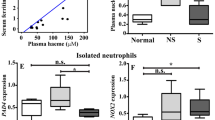Abstract
SIALIC acids (SA) of the red blood cell (RBC) membrane are considered to play an important part in the physiology of the RBC1. There are indications that the amount of membrane sialic acid is a major factor in distinguishing young from aged RBC. Thus, ageing of circulating RBC is associated with a reduction of 20–30% SA which may be an important determinant of RBC survival2,3 in the eventual recognition and sequestration of the latter cells by the reticuloendothelial system2. During studies of thalassaemic RBC we observed, among other alterations, that the average level of SA was approximately 25% less than in normal RBC membranes obtained from healthy donors4. We, therefore, investigated the comparative ultra-structural distribution of SA on the surface of thalassaemic RBC membranes. We found that the SA residues on the surface of thalassaemic RBC are distributed in an uneven manner and are less abundant than those present on normal RBC surfaces.
This is a preview of subscription content, access via your institution
Access options
Subscribe to this journal
Receive 51 print issues and online access
$199.00 per year
only $3.90 per issue
Buy this article
- Purchase on Springer Link
- Instant access to full article PDF
Prices may be subject to local taxes which are calculated during checkout
Similar content being viewed by others
References
Weinstein, R. S. in The Red Blood Cell (ed. Surgenor, D. MacN.) 1, 213–268 (Academic, New York, 1974).
Durocher, J. R., Payne, R. C. & Conrad, M. E. Blood 45, 11–20 (1975).
Jancik, J., Schauer, R. & Streicher, H.-J. Hoppe-Seyler's Z. physiol. Chem. 356, 1329–1331 (1975).
Kahane, I. & Rachmilewitz, E. A. Israel J. med. Sci. 12, 11–15 (1976).
Bayer, E. A., Skutelsky, E., Wynne, D. & Wilchek, M. J. Histochem. Cytochem. 24, 933–939 (1976).
Skutelsky, E., Danon, D., Wilchek, M. & Bayer, E. A. J. ultrastruct. Res. (in the press).
Danon, D., Goldstein, L., Marikovsky, Y. & Skutelsky, E. J. ultrastruct. Res. 38, 500–510 (1972).
Luft, J. H. Fedn Proc. 25, 1773–1783 (1966).
Eylar, E. H., Madoff, M. A., Brody, O. V. & Oncley, J. L. J. biol. Chem. 237, 1992–2000 (1962).
Weatherall, D. J. & Clegg, J. B. The Thalassaemia Syndromes (Blackwell Scientific, London, 1972).
Polliack, A. & Rachmilewitz, E. A. Br. J. Haematol. 24, 319–326 (1973).
Riggs, M. G. & Ingram, V. M. Biochem. biophys. Res. Commun. 74, 191–198 (1977).
Warren, L. J. biol. Chem. 234, 1971–1975 (1951).
Author information
Authors and Affiliations
Rights and permissions
About this article
Cite this article
KAHANE, I., POLLIACK, A., RACHMILEWITZ, E. et al. Distribution of sialic acids on the red blood cell membrane in β thalassaemia. Nature 271, 674–675 (1978). https://doi.org/10.1038/271674a0
Received:
Accepted:
Issue Date:
DOI: https://doi.org/10.1038/271674a0
This article is cited by
-
The erythrocyte membrane properties of beta thalassaemia heterozygotes and their consequences for Plasmodium falciparum invasion
Scientific Reports (2022)
-
Qualitative and quantitative analysis of erythrocyte surface membrane sialyl residues using affinity cytochemistry with special reference to diabetic patients
Virchows Archiv B Cell Pathology Including Molecular Pathology (1985)
-
Neue Ergebnisse zur biologischen und medizinischen Bedeutung von Glycoproteinen
Klinische Wochenschrift (1979)
Comments
By submitting a comment you agree to abide by our Terms and Community Guidelines. If you find something abusive or that does not comply with our terms or guidelines please flag it as inappropriate.


